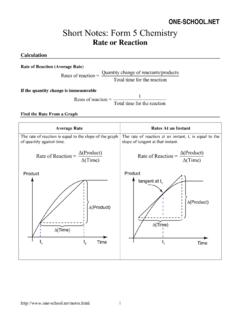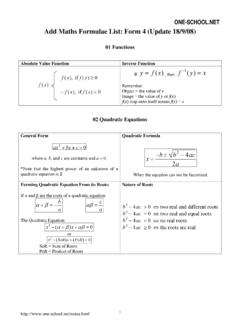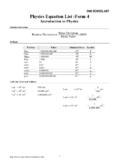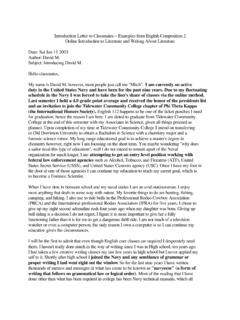Transcription of ONE-SCHOOL.NET Short Notes: Form 4 Chemistry
1 Short notes : form 4 Chemistry Short notes : form 4 Chemistry Chemical Formulae and Equation Chemical Formulae and Equation Calculation Calculation Summary Summary molar volume molar volume molar mass Avogadro Constant Number of particles Mole of particles Mass of particle (in gram) Avogadro Constant molar mass Volume of Gas For Solid, liquid or gas mass of subtancenumber of mole = molar mass Molar mass = RAM/RMM/RFM in gram For gas (only) volume of gasnumber of mole = molar volme Molar volume = 24dm3 at room temperature Molar volume = at For Solution MVnumber of mole = 1000 M = molarity V = Volume of solution in cm3 For quantity of particle(atom,molecule,ion)
2 23quantity of particlenumber of mole = 10 1 Chemical Formula Cation (Positive Ions) Ion Symbol Ion Symbol Ion Symbol Potassium K+ Calcium Ca2+ Aluminium Al3+ Sodium Na+ Magnesium Mg2+ Iron (III) Fe3+ Lithium Li+ Zinc Zn2+ Chromium(III) Cr3+ Hydrogen H+ Barium Ba2+ Argentums(I) Ag+ Iron (II) Fe2+ Mercury(I) Hg+ Tin (II) Sn2+ Ammonium NH4+ Lead(II) Pb2+ Copper(II) Cu2+ Manganese(II) Mn2+ Anion (Negative Ions) Ion Symbol Ion Symbol Ion Symbol Oxide O2- Hydroxide OH- Ethanoate CH3 COO- Fluoride F- Sulphate SO42- Manganate(VII)
3 MnO4- Chloride Cl- Nitrate NO3- Dichromate(VI) Cr2O72- Bromide Br- Carbonate CO32- Phosphate PO43- Iodide I- Thiosulphate S2O32- Formulae for Certain Molecule Karbon monoxide CO Ammonia NH3 Carbon dioxide CO2 water H2O Nitrogen monoxide NO Hydrogen chloride HCl Nitrogen dioxide NO2 Tetrachloromethane CCl4 Sulphur dioxide SO2 Glucose C6H12O6 Sulphur trioxide SO3 Hydrogen bromide HBr Fluorine F2 Hydrogen iodide HI Bromine Br2 Hydrogen sulphide H2S Chlorine Cl2 Ethanol C2H5OH Iodine I2 Ethanoic Acid CH3 COOH 2 Periodic Table Reaction of Group 1 Elements 1. Reaction with Oxygen The entire group 1 metal can react with oxygen to form metal oxide. 4Li + O2 2Li2O 4Na + O2 2Na2O 4K + O2 2K2O The metal oxide of group 1 elements can dissolve in water to form alkali (hydroxide) solution Li2O + H2O 2 LiOH Na2O + H2O 2 NaOH K2O + H2O 2 KOH 2.
4 Reaction with halogen (Chlorine) 2Li + Cl2 2 LiCl 2Na + Cl2 2 NaCl 2K + Cl2 2 KCl 3. Reaction with water The entire group 1 metal can react with water to produce alkali (hydroxide) solution and hydrogen gas. 2Li + 2H2O 2 LiOH + H2 2Na + 2H2O 2 NaOH + H2 2K + 2H2O 2 KOH + H2 Reaction of Group 17 Elements 1. React with water Cl2 + H2O HCl + HOCl Br2 + H2O HBr + HOBr I2 + H2O HI + HOI 2. React with Sodium Hydroxide Cl2 + 2 NaOH NaCl + NaOCl + H2O Br2 + 2 NaOH NaBr + NaOBr + H2O I2 + 2 NaOH NaI + NaOI + H2O 3. React with Iron 3Cl2 + 2Fe 2 FeCl3 3Br2 + 2Fe 2 FeBr3 3I2 + 2Fe 2 FeI3 Preparation of Chlorine Gas 2 KMnO4 + 16 HCl 2 KCl + 2 MnCl2 + 5Cl2 + 8H2O 3 Electrochemistry Electrolyte Ionisation of Electrolyte Ionisation of Molten Compound PbBr2 Pb2+ + Br- NaCl Na+ + Cl- Al2O3 2Al3+ + 3O2- Ionisation of Aqueous Solution NaCl Na+ + Cl- H2O H+ + OH- HCl H+ + Cl- H2O H+ + OH- CuSO4 Cu2+ + SO42- H2O H+ + OH- Discharge of Positive Ion Discharge of Negative Ion Na+ + e Na Observation: Grey deposit is formed.
5 Al3+ + 3e Al Observation: Grey deposit is formed. Pb2+ + 2e Pb Observation: Grey deposit is formed. Cu2+ + 2e Cu Observation: Brown deposit is formed. Ag+ + e Ag Observation: Silver deposit is formed. 2H+ + 2e H2 Observation: Gas bubble is formed. A pop sound is produced when a lighted splinter is placed near the mouth of the test tube. 2Cl- Cl2 + 2e Observation: Bubbles of pungent yellowish green gas are produced. The gas turns moist litmus paper to red and then bleaches it. 2Br- Br2 + 2e Observation: Molten electrolyte: Brown colour gas is produced. Aqueous solution: Light brown solution is formed. 2I- I2 + 2e Observation: Molten electrolyte: Brown colour gas is produced.
6 Aqueous solution: Light brown solution is formed. The solution turns blue when a few drops of starch solution is added in. 4OH- O2 + 2H2O + 4e Observation: Gas bubble is formed. Gas produces light up a wooden splinter. 4 Acid and Base Ionisation of Acid Hydrochloric Acid HCl H+ + Cl- HCl + H2O H3O+ + Cl- Nitric Acid HNO3 H+ + NO3- HNO3 + H2O H3O+ + NO3- Sulphuric Acid H2SO4 H+ + SO42- H2SO4 + 2H2O 2H3O+ + SO42- Ethanoic Acid CH3 COOH H+ + CH3 COO- CH3 COOH + H2O H3O+ + CH3 COO- Chemical Properties of Acid Acid + Reactive Metal Salt + H2 Example: 2 HCl + Zn ZnCl2 + H2 6 HNO3 + 2Fe 2Fe(NO3)3 + 3H2 H2SO4 + Pb PbSO4 + H2 6CH3 COOH + 2Al 2Al(CH3 COO)3 + 3H2 Acid + Metal Oxide Salt + H2O Example.
7 2 HCl + ZnO ZnCl2 + H2O 2 HNO3 + MgO Mg(NO3)2 + H2O H2SO4 + CuO CuSO4 + H2O 2CH3 COOH + Na2O 2CH3 COO-Na++ H2O Acid + Metal Hydroxide Salt + H2O Example: 2 HCl + Ca(OH)2 CaCl2 + 2H2O HNO3 + NaOH NaNO3 + H2O H2SO4 + 2NH4OH (NH4)2SO4 + 2H2O or H2SO4 + 2NH3 (NH4)2SO4 CH3 COOH + KOH CH3 COO-K+ + H2O Acid + Metal Carbonate Salt + CO2 + H2O Example: 2 HCl + ZnCO3 ZnCl2 + CO2 + H2O 2 HNO3 + CaCO3 Ca(NO3)2 + CO2 + H2O H2SO4 + Na2CO3 Na2SO4 + CO2 + H2O 2CH3 COOH + MgCO3 Mg(CH3 COO)2 + CO2 + H2O 5 Salt Solubility of Salt Salt Solubility Salt of potassium, sodium and ammonium All are soluble in water Salt of nitrate All are soluble in water Salt of sulphate Mostly soluble in water except: (Pb) Lead sulphate (Ba) Barium sulphate (Ca) Calcium sulphate Salt of chloride Mostly soluble in water except: (Pb) Lead chloride (Ag) silver chloride (Hg) mercury chloride Salt of carbonate Mostly insoluble in water except.
8 Potassium carbonate Sodium carbonate Ammonium carbonate Oxide and Hydroxide Solubility Oxide Mostly insoluble in water except: K2O and Na2O. Hydroxide Mostly insoluble in water except: NH4OH, KOH and NaOH Preparation of Salt Preparation of Soluble Salt Salt of Potassium, Sodium and Ammonium Acid + Alkali Salt + Water Example: Preparation of Sodium Chloride (NaCl) HCl + NaOH NaCl + H2O Salt of non-Potassium, Sodium and Ammonium Acid + Reactive metal Salt + Hydrogen Gas Acid + Metal Oxide Salt + Water Acid + Metal Carbonate Salt + Water + Carbon Dioxide Example: Preparation of Zinc Sulphate (ZnSO4) H2SO4 + Zn ZnSO4 + H2 H2SO4 + ZnO ZnSO4 + H2O H2SO4 + ZnCO3 ZnSO4 + H2O + CO2 6 Preparation of Insoluble Salt Ionic Precipitation Insoluble salts can be made by double decomposition.
9 This involves mixing a solution that contains its positive ions with another solution that contains its negative ions. Example: Preparation of Silver Nitrate AgNO3 (aq) + NaCl (aq) AgCl (s) + NaNO3 (aq) Ag+ (aq) + C1- (aq) AgCl (s) (ionic equation) Colour of Salt Salt or metal oxide Solid Aqueous solution Salt of: Sodium, Calcium, Magnesium, Aluminium, zinc, Lead, ammonium Chloride, sulphate, nitrate, carbonate White Colourless Salt of Copper(II).- Copper(II) Carbonate Green Insoluble Copper(II) sulphate, Copper(II) nitrate, Copper(II) chloride Blue Blue Copper(II) oxide Black Insoluble Salt of Iron (II) Iron(II) sulphate; Iron(II) nitrate; Iron(ID chlorideGreen Green Salt of Iron (III).)
10 Iron(III) sulphate; Iron(III) nitrate; Iron(III) chloride Brown Brown Lead Iodide Yellow Insoluble Lead Chloride White Insoluble Zink oxide Yellow when it is hot and white when it is cold. Insoluble Lead(II) oxide- Brown when it is hot and yellow when it is cold. Insoluble Magnesium oxide, Aluminium oxide White Insoluble Potassium oxide, Sodium oxide, Calcium oxide White Colourless 7 Heating effect on Salt Heating EffectCO32-NO3-SO42-Cl-Most Probably Release CO2 Most Probably Release NO2 Most Probably Release SO3 Most Probably No effect Heating Effect on Carbonate Salt Carbonate Salt Equation of The Reaction Potassium carbonate Sodium carbonate Not decomposible Calcium carbonate Magnesium carbonate Aluminium carbonate Zinc carbonate Iron (III) carbonate Lead(II) carbonate Copper(II) carbonate CaCO3 CaO + CO2 MgCO3 MgO + CO2 Al2(CO3)3 Al2O3 + 3CO2 ZnCO3 ZnO + CO2 Fe2(CO3)




